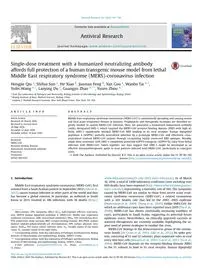
2016 Single-dose treatment with a humanized neutralizing antibody affords full protection of a human transgenic mouse mo PDF
Preview 2016 Single-dose treatment with a humanized neutralizing antibody affords full protection of a human transgenic mouse mo
Single-dose treatment with a humanized neutralizing antibody affords full protection of a human transgenic mouse model from lethal Middle East respiratory syndrome (MERS)-coronavirus infection Hongjie Qiu a, Shihui Sun a, He Xiao b, Jiannan Feng b, Yan Guo a, Wanbo Tai a, c, Yufei Wang a, c, Lanying Du c, Guangyu Zhao a, **, Yusen Zhou a, * a State Key Laboratory of Pathogen and Biosecurity, Beijing Institute of Microbiology and Epidemiology, Beijing, China b Beijing Institute of Basic Medical Sciences, Beijing, China c Lindsley F. Kimball Research Institute, New York Blood Center, New York, NY, USA a r t i c l e i n f o Article history: Received 30 March 2016 Received in revised form 19 May 2016 Accepted 12 June 2016 Available online 14 June 2016 Keywords: MERS-CoV Receptor-binding domain Humanized monoclonal antibody Protection Treatment Lethal infection a b s t r a c t Middle East respiratory syndrome coronavirus (MERS-CoV) is continuously spreading and causing severe and fatal acute respiratory disease in humans. Prophylactic and therapeutic strategies are therefore ur- gently needed to control MERS-CoV infection. Here, we generated a humanized monoclonal antibody (mAb), designated hMS-1, which targeted the MERS-CoV receptor-binding domain (RBD) with high af- finity. hMS-1 significantly blocked MERS-CoV RBD binding to its viral receptor, human dipeptidyl peptidase 4 (hDPP4), potently neutralized infection by a prototype MERS-CoV, and effectively cross- neutralized evolved MERS-CoV isolates through recognizing highly conserved RBD epitopes. Notably, single-dose treatment with hMS-1 completely protected hDPP4 transgenic (hDPP4-Tg) mice from lethal infection with MERS-CoV. Taken together, our data suggest that hMS-1 might be developed as an effective immunotherapeutic agent to treat patients infected with MERS-CoV, particularly in emergent cases. © 2016 The Authors. Published by Elsevier B.V. This is an open access article under the CC BY-NC-ND license (http://creativecommons.org/licenses/by-nc-nd/4.0/). 1. Introduction Middle East respiratory syndrome coronavirus (MERS-CoV), first isolated from a Saudi Arabian patient in September 2012 (Zaki et al., 2012), causes human infection in other parts of the world and thus has become a global concern. In particular, an outbreak in South Korea in 2015 resulted in 186 infections with 36 deaths (http:// www.who.int/csr/don/21-july-2015-mers-korea/en/). As of March 16, 2016, a total of 1,690 laboratory-confirmed cases including over 600 deaths have been reported (http://www.who.int/emergencies/ mers-cov/en/), representing a mortality rate of 36%. The symptoms caused by MERS-CoV are similar to those from severe acute respi- ratory syndrome coronavirus (SARS-CoV), a related coronavirus with a 10% fatality rate that led to the 2002e2003 epidemic (Skowronski et al., 2004; Zhong et al., 2003). Unlike SARS-CoV, for which no additional cases have been reported since 2005 (Du et al., 2009), MERS-CoV has shown continually increasing numbers of cases, particularly in Saudi Arabia, suggesting its potential future epidemic status. Nevertheless, no clinically approved vaccines or antiviral therapeutics are currently available, highlighting the ur- gent need of potent strategies to combat this virus. MERS-CoV belongs to the Betacoronavirus genus of the corona- virus family (de Groot et al., 2013; Zaki et al., 2012). Its spike pro- tein, consisting of S1 and S2 subunits, plays important roles in viral entry into host cells (Bonavia et al., 2003; Gao et al., 2013; Xu et al., 2004). MERS-CoV depends on the receptor-binding domain (RBD) in the S1 subunit to bind to its viral receptor, human dipeptidyl Abbreviations: CPE, cytopathic effect; EC50, half-maximal effective concentra- tion; hDPP4, human dipeptidyl peptidase 4; MERS-CoV, Middle East respiratory syndrome coronavirus; mAb, monoclonal antibodies; ND50, 50% neutralizing dose; PCR, polymerase chain reaction; RBD, receptor binding domain; SDS-PAGE, sodium dodecyl sulphate-polyacrylamide gel electrophoresis; SPR, surface plasmon reso- nance; TCID50, 50% tissue culture infective dose; VH, variable region of the heavy chain; VL, variable region of the light chain. * Corresponding author. State Key Laboratory of Pathogen and Biosecurity, Beijing Institute of Microbiology and Epidemiology, Beijing, 100071, China. ** Corresponding author. State Key Laboratory of Pathogen and Biosecurity, Beijing Institute of Microbiology and Epidemiology, Beijing, 100071, China. E-mail addresses:
